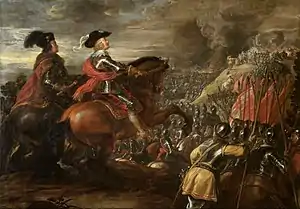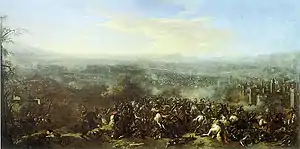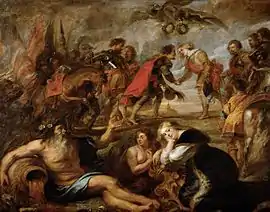Battle of Nördlingen (1634)
The Battle of Nördlingen (German: Schlacht bei Nördlingen; Spanish: Batalla de Nördlingen; Swedish: Slaget vid Nördlingen) was fought in 1634 during the Thirty Years' War, on 27 August (Julian calendar) or 6 September (Gregorian calendar). The Roman Catholic Imperial army, bolstered by 15,000 Spanish soldiers, won a crushing victory over the combined Protestant armies of Sweden and their German-Protestant allies (Heilbronn Alliance).
| Battle of Nördlingen | |||||||
|---|---|---|---|---|---|---|---|
| Part of the Thirty Years' War | |||||||
 The Battle of Nördlingen by Jan van den Hoecke | |||||||
| |||||||
| Belligerents | |||||||
|
Heilbronn League |
| ||||||
| Commanders and leaders | |||||||
|
Gustav Horn (POW) Bernhard of Saxe-Weimar Johann Philipp Kratz von Scharffenstein (POW) [3] |
Crown Prince Ferdinand Cardinal-Infante Ferdinand | ||||||
| Strength | |||||||
|
25,000[4] 16,000 infantry 9,000 cavalry 68 guns |
33,000[4] 20,000 infantry 13,000 cavalry 50 guns | ||||||
| Casualties and losses | |||||||
| 21,000 killed or captured[4] | 3,500 killed or wounded[4] | ||||||
 Nördlingen Location within Bavaria  Nördlingen Nördlingen (Germany) | |||||||
After the failure of the tercio system in the first Battle of Breitenfeld in 1631, the professional Spanish troops deployed at Nördlingen proved the tercio system could still contend with the deployment improvements devised by Maurice of Orange and Gustavus Adolphus of Sweden in their respective troops.
Prelude
The Battle of Nördlingen was part of the Thirty Years' War, fought from 1618 to 1648. The chief belligerents were the Catholic Habsburg dynasties consisting of an Austrian and Spanish branch and their allies on one side. (The Austrian archduke also held the title of Holy Roman Emperor. For this reason, the Austrian Habsburgs are frequently referred to as the Imperialists.) Opposed to them were the Protestant nations comprising the Dutch, Denmark, Sweden, various German principalities and later, Catholic France.
After the Protestant victory at the Battle of Lützen two years before, the Swedes failed to follow up due to the death of their king, Gustavus Adolphus. As a result, the Imperial forces began to regain the initiative.
In 1634 Protestant German and Swedish forces moved south and invaded Bavaria, threatening a major Habsburg ally. In response, the Austrian Habsburg commander, Ferdinand of Hungary (son of Ferdinand II, the Holy Roman Emperor) advanced west from Bohemia (today, the Czech Republic) threatening to cut across the supply lines of the Protestant armies. Consequently, the Protestant commanders quickly reversed course and headed north. They were aware that Spanish reinforcements under Ferdinand of Hungary's cousin, the Cardinal-Infante Ferdinand of Austria, were en route from their dominions in Northern Italy. The Spanish army had marched through the Stelvio Pass trying to open a new "Spanish Road", and take their Commander to his Governorship in the Spanish Low Countries.
The Protestant commanders decided they could not ignore the threat of a union between the two enemy forces and combined their two largest armies near Augsburg on 12 July, which included the Swabian-Alsatian Army under Gustav Horn and the so-called Franconian Army under Bernhard of Saxe-Weimar. Both armies were named after their main operation area and belonged to the Heilbronn Alliance (Sweden's German-Protestant allies under the directorate of the Swedish chancellor Axel Oxenstierna). These forces mostly consisted of German recruits. Among them were the Blue brigade and the Scots in Swedish service ("the Green brigade") with a few national Swedish/Finnish regiments (mostly cavalry) and one national Swedish infantry brigade ("the Yellow brigade").[5][6]
The Protestants proved unable to prevent the fall of Regensburg to Ferdinand of Hungary and desperately pursued him westwards in an effort to prevent the merger of the two Habsburg armies. On 16 August the Cardinal-Infante crossed the Danube at Donauwörth. Despite their best efforts the Protestant armies were still behind when Ferdinand of Hungary set down to besiege the town of Nördlingen in Swabia and await the Cardinal-Infante, who arrived before the city on 2 September - three days before the Protestants.[7]
Battle
The cousins, Ferdinand, brother of the Spanish king and known as the Cardinal-Infante, and Ferdinand of Hungary, son of Ferdinand II, the Austrian Holy Roman Emperor, prepared for battle, ignoring the advice of more experienced generals such as Matthias Gallas. Most felt a full engagement against two of the most experienced Protestant commanders was reckless and unlikely to have positive results. However, the cousins were supported by Count Leganés, the Spanish deputy commander, who was confident in their superior numbers, including the reliable Spanish Infantry.


Bernhard and Horn also prepared for battle. Bernhard felt that no matter the odds, an attempt must be made to relieve Nördlingen. Horn seems to have been reluctant given the state of the Protestant armies, which were short of supplies. Bernard underestimated the numerically superior enemy forces despite information obtained from a prisoner. The Spanish reinforcements numbered closer to 20,000 not 7,000. In addition, the Austrian and Spanish Imperialists possessed 13,000 cavalry. By contrast, the combined Protestant forces numbered 16,000 infantry and 9,000 horse. Also critical was the fact that the terrain features of the battlefield convinced the Protestant commanders to abandon the 3 pounder guns normally attached to each of their infantry brigades, which at previous battles had provided a crucial firepower advantage.[8]
The two Ferdinands drew up their armies between the Protestant forces and the town of Nördlingen, with the left wing anchored at the base of a hill. In the center, Catholic German infantry were placed in front with the Spanish behind them. A contingent of Catholic Germans defended the hilltop.[9]
The Protestant commanders came up with a plan: With half the army, Bernard was to hold the main Imperialist force in check while Horn wheeled the remainder through some woods on the right with the object of taking the hill on the Imperialist left. Once the hill was seized, artillery could be placed on top that would subject the enemy flank to enfilade fire. That would force him to withdraw and relieve Nördlingen.[10]
At sunrise on September 6, Horn commenced his attack, which suffered every kind of bad luck. After laying out careful instructions to his subordinates, the cavalry attacked prematurely, leaving the infantry and artillery behind, when they were supposed to lead. Despite this blunder, the Catholic Germans holding the hilltop panicked, deserting their batteries. However, the wooded features caused two of Horn's brigades to mistake each other for enemy, and they began to exchange fire. Meanwhile, the victorious cavalry dissipated itself chasing down fugitives.[11]

Taking advantage of the confusion in Horn's forces, the Cardinal-Infante sent a detachment of Spanish foot and horse, which reclaimed the hill. Horn was able to rally his men, but by then the hilltop was impregnable. Fifteen assaults were made over the next few hours, all of which were beaten back.[12] Among the defending Spanish forces were the "Tercios Viejos" (Old Tercios), mainly those commanded by Fuenclara, Idiáquez, and Toralto with support from Ottavio Piccolomini's Italian cavalry. The Protestant attacks were led by the brigades Vitzthum, Pfuel and one of the Scots Brigades (Colonel William Gunn), supported by the brigade of Count Thurn (Black and Yellow Regiment).
Meanwhile, in the center, Bernard had avoided battle and prevented the Imperialists from reinforcing their threatened left by skillful use of his artillery.[13] However, the Imperial commanders observed the weakened condition of Bernhard's army, which had sent reinforcements to assist Horn on the right. At the opportune moment, a general advance was ordered that quickly put Bernard's forces to flight. Pursuit of Bernard's troops threatened to cut off any escape route of the Swedish units under Horn, who also promptly broke.
Gustav Horn of Björneborg was captured and his army destroyed. A small remnant of Protestants fled to Heilbronn.
Aftermath

The battle was one of the most crushing victories of the Thirty Years' War. With their forces substantially reduced and many German principalities refusing aid, the Swedes withdrew to Northern Germany where they remained inactive for two years. Consequently, the Protestant German princes made a separate peace with the Emperor in the Treaty of Prague.[14]
The Habsburg triumph at Nördlingen followed by the Treaty of Prague could have been decisive in ending the war, enhancing Habsburg dominance in Europe. Spanish forces were no longer engaged in Germany, and now posed a direct threat to France all along its frontier.
France had long been financing the enemies of the Habsburgs, but now they no longer were strong enough to be relied upon. France therefore intervened directly against the Habsburgs by declaring war against Spain on May 21, 1635. This opened a second front against the Spanish Netherlands. Bernard of Saxe-Weimar was given 12,000 French troops and extensive funding.[15]
The Swedes recovered. In 1636, two years after Nördlingen, they defeated a combined Imperial and Saxon army at the Battle of Wittstock, followed later by victories at the Second Battle of Breitenfeld, the battle of Jankov, and the battle of Zusmarshausen.
References
- William Guthrie (2002). Battles of the Thirty Years' War: from White Mountain to Nordlingen, 1618-1635 ISBN 0-313-32028-4
- Norwich, Viscount John Julius (31 May 2011). The Popes: A History. p. 325. ISBN 9781446468500.
- Wilson 2011, pp. 545–549.
- David, Saul (2012). The Encyclopedia of War. ISBN 9781409386643.
- Julius Mankell. Uppgifter rörande swenska krigsmaktens styrka, sammsättning och fördelning, Stockholm 1865 p.198-202
- Peter Engerisser, Pavel Hrncirik (2009). Nördlingen 1634 p.252
- The Thirty Years' War, C.V. Wedgewood.
- "Cannon". www.syler.com. Retrieved 23 March 2018.
- "The Thirty Years War", Cecily V. Wedgwood, pp. 372–373.
- "The Thirty Years War", Cecily V. Wedgwood, p. 373
- "The Thirty Years War", Cecily V. Wedgwood, p. 374
- "The Thirty Years War", Cecily V. Wedgwood, pp. 374–375
- "The Thirty Year's War", Cecily V. Wedgwood, p. 375
- Cecily V. Wedgwood, The Thirty Years War, pp. 380, 385-386, 391
- Wedgwood, pp. 380, 390-391
Sources
- Wilson, Peter (2011). The Thirty Years War: Europe's Tragedy. London: Belknap Press. ISBN 978-0-674-06231-3.
External links
| Wikimedia Commons has media related to Battle of Nördlingen. |